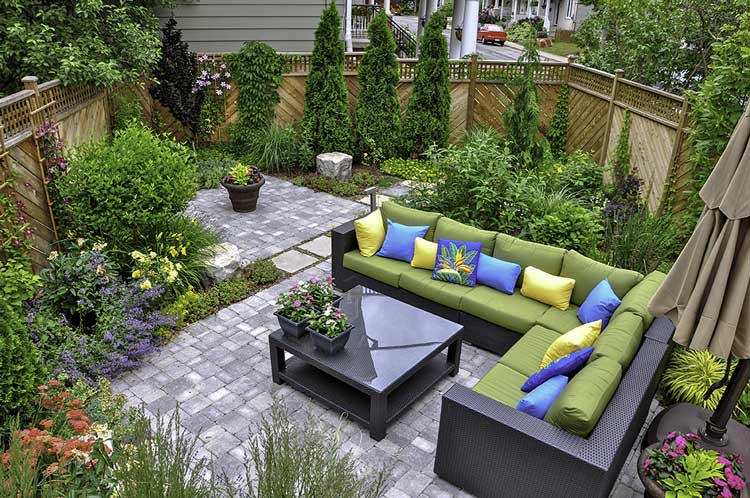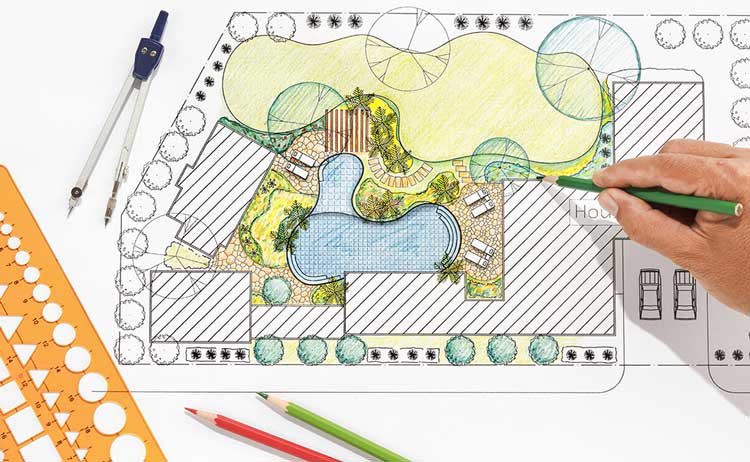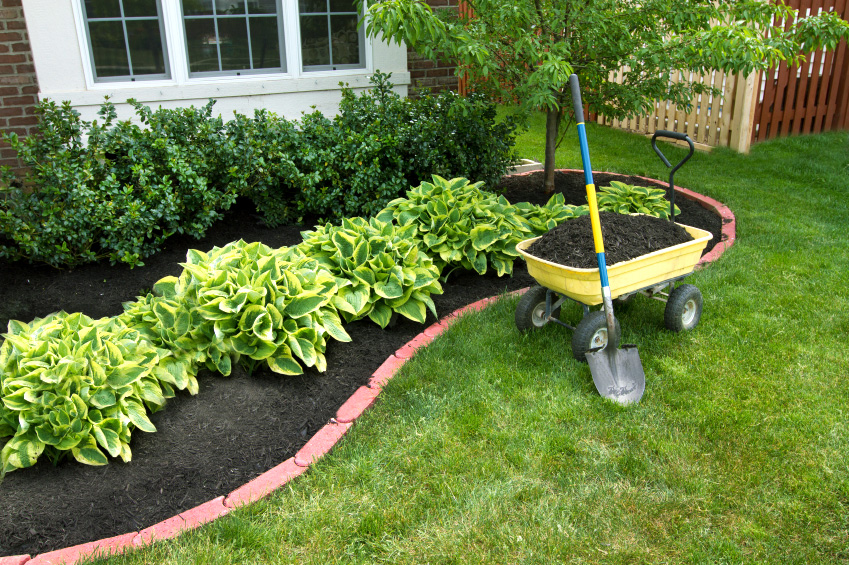Last updated July 2025

If your home is your castle, the landscape around it is the grounds, gardens, and maybe moat. Getting help with landscaping isn’t limited to planting bushes and flowers; it’s also about hardscaping (patios, walks, etc.), placing trees in spots taking advantage of sun and drainage, and plotting out how to best use your property. “A well-conceived outdoor space goes a long way toward improving your quality of life,” said Kona Gray, president of the American Society of Landscape Architects. “So you need to think carefully about how plants, hardscaping, and other elements work together.”
You can work with a landscape architect or designer or a landscaping company to plan or install entire environments (plants, grading, walls, and walks, etc.). Some garden centers offer landscaping services. And, of course, it’s also a project you can tackle yourself.
If you want to hire help, there isn’t one answer for which type of pro is needed to design and execute your ranch-home backyard or townhouse terraced garden. Some landscaping companies can do everything from paving to planting. Like architects, most landscape architects just do designs, meaning you’ll have to hire other companies (garden centers, deck builders, cement contractors) to complete your project. Here at Checkbook.org you’ll find ratings and reviews for all these types of services. Below, we focus primarily on getting help from landscaping businesses.
Getting Ready
Before hiring a landscape pro, consider your space and what you want to do with it, knowing that your plan will evolve. Before you dig in, think about:
- What’s your budget? A few thousand dollars could pay for redoing an existing garden but not a complete renovation or hardscaping work.
- Are you going for a specific theme, such as English meadow or Zen-meditation garden?
- Do you want to rip up and replace everything, or preserve and complement what’s already there?
- Do you need hardscaping, such as a wall, path, or patio? A new fence, deck, or gazebo?
- Do you want to retain or create a large open space where kids or pets can roam?
- Do you want plantings that require little maintenance, or are you willing to play an active role in keeping things up?
- Do you want hardy water-thrifty plantings, or are you willing to sacrifice some time (and money) to keep everything irrigated?
- Do you want a range of flowering varieties that will provide constant color? Fruit and vegetable plants?
- Do you want new plantings that create privacy?
- Do you need to solve drainage problems or issues with deer or other garden-chomping critters?
For inspiration, consult gardening and landscaping websites, magazines, books, and social media accounts, or walk through your neighborhood.

Selecting Design Help
Landscaping companies can either do both design and installation, or provide a plan that you or a pro gardener or hardscaper implements. You can also hire a landscape architect or designer to draw up plans. Some design pros will also supervise the installation.
Landscape design is increasingly professionalized. Landscape architects have bachelor’s or master’s degrees, and must be licensed to produce stamped blueprints. Still, many landscaping contractors don’t employ degreed designers but have experienced staff that do good work.
“The easiest way to understand the difference between landscape designers and installers is to compare the former to architects who plan buildings,” said Gray. “If you’re doing anything structural—building retaining walls, changing the levels of the land—then you probably want a landscape designer.”
Find an easy-to-talk-to pro whose taste matches yours and you’ll get good results. Show potential designers your property and listen to their ideas—many will offer suggestions you hadn’t thought of. “That’s the fun part, where clients share dreams and wishes, and then landscapers can apply practical knowledge to it,” said Washington, D.C., landscape architect Kate Ries.
Look at their online portfolios, or tour spaces they have designed. Talk to previous clients about their experiences.
Not all landscape designers or landscape installers have expertise in all areas. If you want a stone wall or path, an irrigation system, or regrading, seek companies experienced at those tasks.
Get a written agreement with specifics on what the designer will do, including detailed drawings and notes about what will be planted where. The agreement should include details of all hardscape elements, needed materials, and site-preparation work. You should have the chance to review the plans before they are finalized.

Your Role in the Planning
As the designer’s work progresses, review the plan and give feedback. Specific questions to ask:
How will the plants recommended by the designer fit your tastes and needs? Plants should both look great and suit your property’s soil type, drainage, and sunlight exposure. You might discuss suggested plantings with an independent source, such as a master gardener affiliated with an area cooperative extension service.
What will you have to do? If it sounds like too much maintenance, ask for revisions to make the future work more manageable and affordable.
How large will provided plants be now and when they mature? Discuss how your property will look both right away and years from now. Without good planning, you could find yourself with an assortment of plants that do not complement each other in size, shape, or color.
“Fast-growing” isn’t always a desirable trait in landscaping. One trick used by some full-service landscaping companies is to suggest and plant quick-growing varieties that require a lot of upkeep and trimming, hoping you’ll hire them to do maintenance work.

Choosing and Dealing with the Installer
Once you have a plan, unless you want to DIY you’ll need a company to do the installation. You can hire the designer’s company if it also does installation, but you may save money and get better work elsewhere. If the designer doesn’t do installs, ask them for recommendations.
Many companies doing landscaping installations make many customers unhappy. Our members complain about rude staff, delays and no-shows, and communication breakdowns as well as dire issues such as deposits stolen with no work done or plantings that die quickly with companies unwilling to provide replacements.
Ask any companies you consider to provide addresses of properties where they have done installations, and go look at the work.
When you consult companies, get answers to the following questions, and include them in the contract you sign:
If the company will be buying plants to install, where will it buy them? Cross-check their sources against our ratings of area garden centers to be sure they’re buying quality ferns, fir trees, or whatever.
What will I need to do to keep things up? Conflicts between landscapers and customers frequently occur when plants die sooner than expected.
What guarantees do you get? If you do your part, but plants die or fail to thrive, will the company replace them for free? How long are walls and other structures guaranteed to last? A solid, unambiguous guarantee is a sign of quality.
How quickly can work start, and how long will it take to complete it?
If there are existing plantings you want to retain, how will the company make sure they remain undisturbed? To be safe, the contract should include a list or drawing indicating the placement and number of plants you want to keep.
Will the company take proper steps to identify and avoid underground utility lines? Before any digging, the proper authorities should locate and mark the location of all underground lines. If a company tells you this step is unnecessary, call 811 to confirm.
Will the landscaper use pesticides or herbicides? If so, what precautions are necessary to prevent them from harming your family, your pets, and wildlife? If pesticides are to be used, require the company to prove it will use a certified applicator.
Who actually will do the work? Company employees? Day laborers? Will the same crew show up each day? Who will supervise?
How large a deposit is required? It’s reasonable for companies to require small down payments so they don’t have to front all the costs of plantings and other materials. But the power to delay payment until work is done as agreed provides great leverage. Arrange to pay all or a large part of the price after installation.
Will the company provide credit references? A good way to check the stability of companies is to ask suppliers if they pay their bills on time. Good credit also reduces the chances of an unpaid supplier placing a lien on your home.
Does the company have insurance coverage for liability and worker’s compensation claims? If not, you could be liable for claims.
If heavy equipment is needed, how will the company minimize damage from it? How will equipment access the work area? Some companies use specialized rubber-tracked equipment that does little damage to lawns. Others try to undo damage they create by reseeding and resodding.
Who is responsible for hauling away debris? Preferably, the contract should call for the landscaper to handle this task.

Don’t Overpay
Once you have a detailed landscaping plan, use it to obtain price quotes from multiple installation companies. Get a fixed-price contract for all the work and materials the company will supply.
You’ll find tremendous price variation from company to company for the same work; we find that some companies charge twice what others do for the same tasks. Since buying plants is one of the few businesses where there is an apparent price-quality relationship, some price differences might stem from the plants that landscapers purchase. But that does not explain away all of the cost differences we see—some companies just charge high prices.
If you want a landscaper to provide continuing maintenance services, make sure you understand what you’ll get for the price—and what will cost extra. Disreputable landscapers commonly bill monthly fees for maintenance, and then charge extra for tasks like “spring cleanup” or “fall cleanup.” Make sure that any maintenance agreement specifies which tasks are to be done and how often.
Supervise
As work progresses, make sure the company sticks to its agreement, and do your part to keep the job running smoothly:
- Stay engaged. Once work begins, check in daily and if you have questions or complaints, bring them up.
- Check plants as they arrive and before they are planted for signs of trouble. For tips on plant quality, see our article on garden nurseries.
- Keep in mind that delays due to weather aren’t the contractor’s fault.
- Provide a bathroom for workers.
- If you do your part but plants don’t thrive, immediately ask the company to inspect them and, if necessary, replace them.


